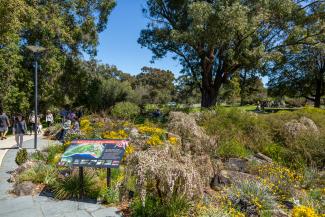What is a botanic garden?
You know it as a beautiful destination in the heart of Perth, but the Western Australian Botanic Garden serves a much bigger purpose in preserving flora for the future.
Botanic gardens are institutions holding documented collections of living plants for the purposes of scientific research, conservation, display and education.
The Western Australian Botanic Garden plays a vital role in the ex-situ conservation of Western Australian flora and operates in line with an Ex-Situ Conservation Strategy. Ex-situ is the term used to define the conservation of flora away from its natural habitat.
We work actively to promote the value of plant biodiversity, connect visitors to nature, and prevent species extinctions and support their continued survival in the wild.
To be considered a botanic garden, an institution must meet in part or whole the following criteria:
- Have a reasonable degree of permanence.
- There is an underlying scientific basis for the collections.
- Proper documentation of the collections including wild origin.
- Plants are monitored within the collections.
- Is open to the public.
- Communicate information to other gardens institutions and the public.
- Exchange seed or other materials with other botanic gardens, arboreta or research institutions.
- Undertake scientific or technical research on plants in the collections
- Maintain research programs in plant taxonomy in associated herbaria.
The Western Australian Botanic Garden has a large role to play in plant science and conservation, as well as inspiring the public to appreciate the vital role of Western Australian plants to the State.
Plant species and communities in WA are at-risk from myriad threats including habitat loss, biosecurity risks from diseases and invasive species, and changing climate and fire regimes. With more than 430 threatened plant species and more than 100 threatened ecological communities in Western Australia, there is a pressing need to increase conservation capacity and actions.
